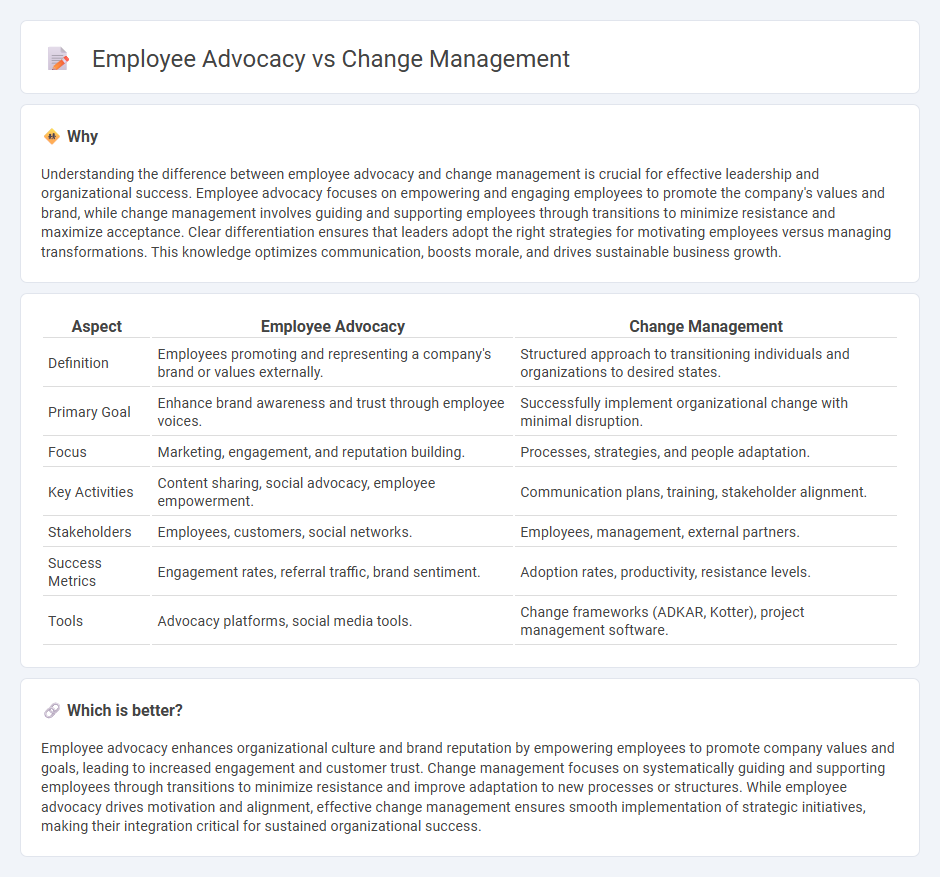
Employee advocacy drives engagement by empowering staff to promote company values and culture, boosting brand reputation and internal morale. Change management systematically guides organizational transitions by aligning processes, minimizing resistance, and ensuring successful adoption of new strategies. Explore deeper insights into how each approach shapes effective leadership and organizational success.
Why it is important
Understanding the difference between employee advocacy and change management is crucial for effective leadership and organizational success. Employee advocacy focuses on empowering and engaging employees to promote the company's values and brand, while change management involves guiding and supporting employees through transitions to minimize resistance and maximize acceptance. Clear differentiation ensures that leaders adopt the right strategies for motivating employees versus managing transformations. This knowledge optimizes communication, boosts morale, and drives sustainable business growth.
Comparison Table
| Aspect | Employee Advocacy | Change Management |
|---|---|---|
| Definition | Employees promoting and representing a company's brand or values externally. | Structured approach to transitioning individuals and organizations to desired states. |
| Primary Goal | Enhance brand awareness and trust through employee voices. | Successfully implement organizational change with minimal disruption. |
| Focus | Marketing, engagement, and reputation building. | Processes, strategies, and people adaptation. |
| Key Activities | Content sharing, social advocacy, employee empowerment. | Communication plans, training, stakeholder alignment. |
| Stakeholders | Employees, customers, social networks. | Employees, management, external partners. |
| Success Metrics | Engagement rates, referral traffic, brand sentiment. | Adoption rates, productivity, resistance levels. |
| Tools | Advocacy platforms, social media tools. | Change frameworks (ADKAR, Kotter), project management software. |
Which is better?
Employee advocacy enhances organizational culture and brand reputation by empowering employees to promote company values and goals, leading to increased engagement and customer trust. Change management focuses on systematically guiding and supporting employees through transitions to minimize resistance and improve adaptation to new processes or structures. While employee advocacy drives motivation and alignment, effective change management ensures smooth implementation of strategic initiatives, making their integration critical for sustained organizational success.
Connection
Employee advocacy plays a crucial role in change management by fostering a culture of trust and open communication, which increases employee engagement during organizational transitions. Advocates within the workforce act as change champions, facilitating smoother implementation by addressing concerns and promoting the benefits of change initiatives. This connection enhances overall adoption rates and reduces resistance, driving successful transformation outcomes.
Key Terms
**Change Management:**
Change management involves structured approaches to transitioning individuals, teams, and organizations from a current state to a desired future state, emphasizing communication, training, and stakeholder engagement to minimize resistance. Effective change management drives successful adoption of new processes, technologies, or cultural shifts by aligning leadership support and employee involvement. Discover how mastering change management can transform organizational resilience and performance.
Communication
Change management emphasizes transparent, consistent communication to guide employees through organizational transitions, reducing resistance and fostering adaptability. Employee advocacy leverages authentic communication where employees actively promote company values and initiatives, enhancing brand credibility and engagement. Explore how strategic communication bridges change management and employee advocacy for sustained business success.
Stakeholder Engagement
Change management focuses on aligning stakeholders through clear communication, training, and feedback to ensure successful adoption of organizational changes. Employee advocacy enhances stakeholder engagement by leveraging passionate employees to promote and support change initiatives, fostering trust and buy-in across all levels. Discover how integrating both strategies can maximize stakeholder commitment and drive transformative results.
Source and External Links
What is Change Management? Definition & Process - Change management involves a systematic approach to handle organizational changes by establishing clear visions, training employees, and monitoring progress.
What is Change Management? - Change management is a structured method to communicate and implement organizational changes, focusing on people and processes.
What is Change Management? Organizational, Process ... - Change management includes defining change, assessing risks, and planning implementation through a structured framework that engages employees and ensures effective communication.
 dowidth.com
dowidth.com